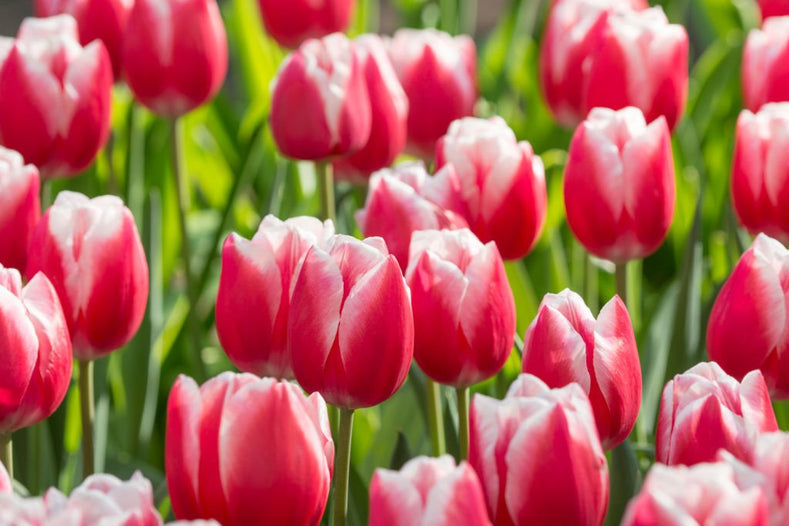Bulbs play an important part in the gardens I design, but maybe the way I use them in my own garden will help other gardeners make a plan for their own garden space.
A bulb catalogue is for me like a sweetshop for a child; my appetite exceeds my capacity to try them all. That said, over the years I have tried many and nowadays I am often surprised by the reappearance of these in odd places in the garden long since forgotten. Such are the delights of gardening, but when I look at the bigger picture, with my designer’s hat on, there are certain key areas where the bulbs in my own garden play a very important role.

I wrote in another blog post about the many marvellous small bulbs that will flower in late winter and early spring. Such bulbs lift our spirits just at the time we need it, at the end of a gloomy winter. I grow most of these here and there in the garden such as the tiny blue Scilla siberica and its more sensational relative Scilla mischtschenkoana ‘Tubergeniana’ and the even earlier flowering yellow winter aconite, Eranthis hyemalis. However, it is the snowdrops that are the most important of this early flowering group of bulbs for me.
It does not really matter which snowdrops you choose to grow; my favourites are the simple Galanthus nivalis and the more dramatic Galanthus elwesii, but they need to be used boldly. Snowdrops will make a dramatic garden feature if used across a wide area of your garden borders. It has taken me a few years to achieve this, but by regularly dividing the clumps shortly after they finish flowering in spring, I have managed to spread them throughout two adjacent borders on one side of the garden. They don’t cover a big area, but it is enough at this bare and open time of the year to have a powerful impact.
Tulips
Tulips are the main theme plants of my garden in spring. Every year I try out different species and cultivars, but for the main show I have different plans for different areas of the garden. In a central border near to the patio I like to play with mixtures of early, mid and late season tulips in a range of pastel tints; every year is different. A second border nearby contains a variety of daffodils and so here I tend to use only yellow, orange or white tulips. A favourite is the reliable Darwinhybrid tulip ‘Daydream’ with its pale yellow flowers that fade to soft orange over a period of a few days. For contrast in form and tone I have often combined it with the Lily-flowered tulip ‘Westpoint’ that opens its flowers to wide yellow stars whenever the sun shines.
Red tulips are used in three other areas of the garden that together create a broad colour theme that seems to fill the whole garden. In reality the red tulips are restricted to just a few square meters each, but repetition is the key to their impact.
Daffodils
I have different varieties of daffodils dotted around the garden that tend to form a recurring theme throughout the garden even though they are not all exactly the same. However, two borders have a more focused theme. The same central border with the mixed tulip theme is home to two very early flowering daffodils. The wild, pure yellow species Tenby daffodil, Narcissus pseudonarcissus subsp. obvallaris and the widely grown cultivar ‘Jetfire’. Both share exactly the same yellow colouring with the addition of a neat orange trumpet in the case of Narcissus ‘Jetfire’.
A separate border is planted generously with just a single cultivar, ‘Barrett Browning’. Again this is an early flowering variety, so as not to dilute the red tulip display in the same space a week or so later and also to make a clear contrast with the yellow flowered daffodils in the adjacent central border.
Summer Snowflakes
The common name of Leucojum aestivum ‘Gravetye Giant’ is misleading as it flowers in spring along with the mid and late flowering tulips and many daffodils. To say it was planned as a major theme in my own garden would not be true but over the years their clumps have expanded into bold features. Again repetition in various parts of the garden amplifies their impact.
Summer Bulbs
Alliums and Camassias are in flower once the spring bulbs finish and are crucial in moving the garden on into its summer dress. If you understand what the June gap is then you definitely need to plant lots of ornamental onions. I had planted, maybe a few dozen Allium ‘Purple Sensation’ some fifteen years ago and now through seeding they fill a border with their purple pompom flower heads. This border has a bold late summer planting scheme, but in May the combination of my alliums and just one perennial is spectacular. If you have moist or heavy soil Euphorbia palustris will thrive to form bulky, waist high clumps of fresh yellow flower in early summer. It creates the perfect setting for tall growing alliums and the blue flower spikes of Camassia quamash (Syn. C. esculenta).
Of the many other bulbs that might be grown throughout the summer there is only really one that features prominently in my own garden, the Summer Hyacinth, Galtonia candicans. It has erect strap-shaped leaves and erect stems carrying cone-shaped terminal racemes of nodding, bell-shaped white with green flowers. Growing to over a meter tall this Galtonia species sits perfectly in naturalistic planting schemes where it is in scale with the many taller growing perennials and ornamental grasses.
To list all the bulbs growing in my garden would be pointless, but when making a plan it is the role that each plays in the total planting scheme that needs to be taken into account. And of course I always order a few extra varieties each year as a luxurious treat, who could resist?





